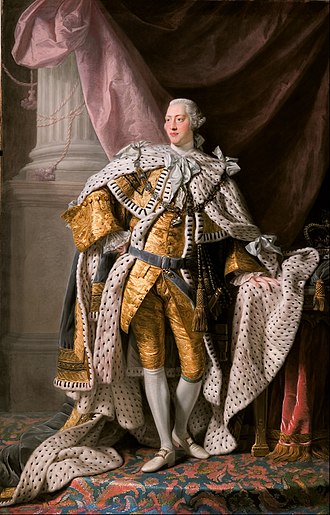George III
King George III (born George William Frederick, 4 June 1738 – 29 January 1820) was King of Great Britain and Ireland from 25 October 1760 to 1 January 1801, when he became King of the United Kingdom of Great Britain and Ireland until his death. He was also Elector of Hanover, which made him a Prince of the Holy Roman Empire.
| George III | |||||
|---|---|---|---|---|---|
 Portrait by Allan Ramsay, 1762 | |||||
| King of the United Kingdom and Hanover | |||||
| 25 October 1760 – 29 January 1820 | |||||
| 22 September 1761 | |||||
| Predecessor | George II | ||||
| Successor | George IV | ||||
| Born | 4 June 1738 Norfolk House, London, England | ||||
| Died | 29 January 1820 (aged 81) Windsor Castle, Windsor, Berkshire, England | ||||
| Burial | |||||
| Spouse | Charlotte of Mecklenburg-Strelitz | ||||
| Issue | George IV Frederick, Duke of York William IV Charlotte, Princess Royal Edward Augustus, Duke of Kent Princess Augusta Sophia Princess Elizabeth Ernest Augustus, King of Hanover Augustus Frederick, Duke of Sussex Adolphus, Duke of Cambridge Princess Mary Princess Sophia Prince Octavius Prince Alfred Princess Amelia | ||||
| |||||
| House | House of Hanover | ||||
| Father | Frederick, Prince of Wales | ||||
| Mother | Augusta of Saxe-Gotha | ||||
During George's reign, he lost control of the United States of America however the British Empire made major gains in South Asia. His two kingdoms, Great Britain and Ireland, were merged into the United Kingdom of Great Britain and Ireland. Also during his reign, the British were at war with republican and Napoleon I's France. The Electorate of Hanover eventually became a Kingdom.
George suffered from periodic bouts of mental illness. One of them caused a crisis in 1788, and attempts were made to nominate his son George IV as regent. The king quickly recovered and prevented that from happening.[1]
George signed the Quebec Act of 1774, which abolished William III's anti-Catholic laws in the American colonies.[2][3] Also during his reign, George III signed legislation abolishing some of the anti-Catholic Laws in Great Britain and Ireland. For example, the Catholic Relief Acts of 1772 and 1774 allowed Roman Catholics to have land leases in Great Britain. In 1793, Hogart's Act allowed Roman Catholics to vote in Irish elections, but George blocked a proposal in 1800 to allow Catholics to sit in the British Parliament.[4]
In the later part of his life, George suffered from recurrent mental illness, which was eventually permanent. Although it has since been suggested that he suffered from a genetic blood disease, porphyria, the cause of his illness is not certain. After a final relapse in 1810, a regency was established, and George's eldest son, George, Prince of Wales, ruled as Prince Regent. On George III's death, the Prince Regent succeeded his father as George IV.
Because of "his plain, homely, thrifty manners and tastes", George III has had the nickname of Farmer George.
Titles and styles
- 4 June 1738 – 31 March 1751: His Royal Highness Prince George[5]
- 31 March 1751 – 20 April 1751: His Royal Highness The Duke of Edinburgh
- 20 April 1751 – 25 October 1760: His Royal Highness The Prince of Wales
- 25 October 1760 – 29 January 1820: His Majesty The King
Ancestors
| George III of the United Kingdom | Father: Frederick, Prince of Wales |
Paternal Grandfather: George II of Great Britain |
Paternal Great-grandfather: George I of Great Britain |
| Paternal Great-grandmother: Sophia Dorothea of Celle | |||
| Paternal Grandmother: Caroline of Ansbach |
Paternal Great-grandfather: John Frederick, Margrave of Brandenburg-Ansbach | ||
| Paternal Great-grandmother: Princess Eleanor Erdmuthe Louise of Saxe-Eisenach | |||
| Mother: Princess Augusta of Saxe-Gotha |
Maternal Grandfather: Frederick II, Duke of Saxe-Gotha-Altenburg |
Maternal Great-grandfather: Frederick I, Duke of Saxe-Gotha-Altenburg | |
| Maternal Great-grandmother: Magdalena Sibylle of Saxe-Weissenfels | |||
| Maternal Grandmother: Princess Magdalena Augusta of Anhalt-Zerbst |
Maternal Great-grandfather: Prince Charles of Anhalt-Zerbst | ||
| Maternal Great-grandmother: Sophie of Saxe-Weissenfels |
George III Media
Prince George (right), his brother Prince Edward, and their tutor, Francis Ayscough (later Dean of Bristol), by Richard Wilson, c. 1749
Pastel portrait of George as Prince of Wales by Jean-Étienne Liotard, 1754
Wedding of George and Charlotte of Mecklenburg-Strelitz, oil sketch by Sir Joshua Reynolds, c. 1761
Portrait by Allan Ramsay, 1762
George travelling to the State Opening of Parliament in the Gold State Coach, 1762
Bust by John van Nost the younger, 1767
Portrait by Johan Zoffany, 1771
Pulling Down the Statue of George III at Bowling Green, 9 July 1776, William Walcutt (1854)
Portrait by Johann Heinrich von Hurter, 1781 (Royal Collection)
In A new way to pay the National Debt (1786), James Gillray caricatured King George III and Queen Charlotte awash with treasury funds to cover royal debts, with Pitt handing him another money bag.
References
- ↑ Ireland and the British Empire ed. Kenny, Kevin Oxford University Press 2004 page 79
- ↑ Willis, Robert The Democracy of God: An American Catholicism 2006 iUniverse Inc. page 18
- ↑ "The Quebec Act, 1774". www.solon.org.
- ↑ Ditchfield, G.M. George III: An Essay in Monarchy Pallgrave McMillan 2002 pages 101-102
- ↑ The London Gazette consistently refers to the young prince as "His Royal Highness Prince George" No. 8734. 5 April 1748. p. 3. https://www.thegazette.co.uk/London/issue/8734/page/3 No. 8735. 9 April 1748. p. 2. https://www.thegazette.co.uk/London/issue/8735/page/2 No. 8860. 20 June 1749. p. 2. https://www.thegazette.co.uk/London/issue/8860/page/2 No. 8898. 31 October 1749. p. 3. https://www.thegazette.co.uk/London/issue/8898/page/3 No. 8902. 17 November 1749. p. 3. https://www.thegazette.co.uk/London/issue/8902/page/3 No. 8963. 16 June 1750. p. 1. https://www.thegazette.co.uk/London/issue/8963/page/1 No. 8971. 14 July 1750. p. 1. https://www.thegazette.co.uk/London/issue/8971/page/1
Other websites
| Wikisource has original works written by or about: |
![]() Quotations related to George III at Wikiquote
Quotations related to George III at Wikiquote









